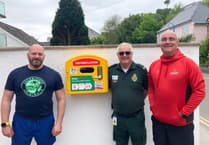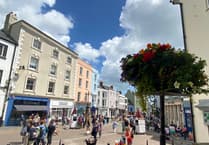Last Friday, the Tenby and District Arts Club had the pleasure of having a presentation from a genuine Japanese lady, in the person of Yoriko Omae. Yoriko works at Pembrokeshire College assisting with their foreign students. When she arrived 16 years ago, there were several Japanese students, due to an affiliation with a college in Hiroshima. Now there is only one Japanese student, but many other nationalities as well. She helps these students to find host families, to learn about British culture and arranges trips and events for them. She also teaches Japanese.
One of the most noticeable differences in our cultures is that Japanese people do not shake hands, but bow when they say hello, sorry etc, and the depth of the bow indicates the importance of the person you are bowing to. The best thing to do in Japan, even if you have little of the language, is to bow to everyone, and that will help matters along greatly!
The Japanese use three different alphabets to write with, two Japanese ones with 15 letters or sounds in each, and the Chinese Kanji or characters. They use a mixture of all three to write a sentence.
It takes 13 hours by plane to get to Japan, but it is nearly on the same latitude as Britain, just a bit further south. There are three large islands and thousands of smaller ones. Tokyo is the capital, with Mount Fuji nearby. As it is such a long country, the climate varies from quite cold at the northern end to semi-tropical at the southern tip.
The seasons are distinctive, with cherry blossoms heralding spring, a hot summer with firework displays and shredded ice to eat, lovely autumn colours, and snow in the winter - Tokyo has had the most snow this winter in 50 years.
When visiting Tokyo, the highlights are the Tokyo tower, which is the symbol of Tokyo and was the tallest building when it was built in the '50s, and the Imperial Palace, home of the Emperor and Empress, but partly open to the public. The Kaminarimon or Thunder Gate is a temple in Tokyo with a large lantern and shops on both sides leading to the temple. The Tsukiji is the biggest fish market in Japan, and sells tuna up to 300 lbs, mainly used for sushi.
The bullet train was built in 1964 for the Olympics, and firstly went from Tokyo to Osaka at 200mph. It is very efficient and punctual, and goes past Mount Fuji, which is 3,700m high.
In Kyoto, be sure to see the Kinkakuji or Golden Pavilion, which is covered in gold leaf and was a shogun's palace in the 14th century. The shogun would have retreated here to go boating, to write poems and to drink sake. It has burned down twice, most recently in the 1950s, but was faithfully rebuilt. The Kiyomizu Temple and Sanju Sangen Do, which has thousands of statues of Buddha, are also worth seeing. Another shogun's castle, Nijo is famous for its floor designed to squeak to warn of assassins, known as the nightingale floor.
Ryoanji has a Japanese Zen garden, where monks meditate. The rocks represent islands in the sea of gravel which is carefully raked by the monks. The Gion District is a preserved old area where geisha and maiko (trainee geisha) can be seen. They are skilled entertainers, dancing, singing and playing the Japanese guitar.
Nara, south of Kyoto, was the capital of Japan for a few hundred years before it moved to Kyoto. Buddhism arrived in Japan during this period, and Nara has the largest indoor statue of Buddha at 50m high. The Fushimi Inari Shrine is a Shinto shrine (the original and still popular animist religion) to the God of rice, which symbolises money, so many businesses give to it.
At Hiroshima, the peace park dedicated to the 300,000 people who died in the first atomic bomb in 1945, has a statue of the girl, Sadako Sasaki, who died of leukaemia gained from the effects of the atomic bomb, but spent her time making paper cranes symbolising peace, in an attempt to make a thousand before she died.
Okinawa is the southernmost island, and has an American base. It was the only part of Japan where fighting took place during WWII.
A key feature of Japanese culture is the tea ceremony - which uses a powdered whisked tea which Yoriko admitted was an acquired taste, and requires cake to take away the bitterness! Flower arranging started as a decoration for the tea ceremony, and calligraphic scrolls also began this way.
Kabuki is a musical entertainment with ornate clothes and make-up, which started as street entertainment in the 1600s. Kabuki actors, still all men, are popular like pop stars. The Noh theatre is a masked dance musical, and Bunraku is a puppet show.
Japanese food covers sushi, which is a lot more than raw fish, and sashimi, which is just raw fish! Tempura is battered fried fish, and Udon are noodles, used at New Year, as they go down smoothly so represent a smooth start to the new year! Traditional Japanese homes did not have an oven in the kitchen, so baking is not a part of Japanese cooking. Sweets are usually bought ready made.
Traditional Japanese dress is the Kimono for men and women, now worn for weddings and other special occasions as it is quite expensive and difficult to wear. The summer Kimono in cotton rather than silk is the Yukata.
Yoriko kindly chatted to everyone afterwards, and people made the most of having a Japanese in Tenby! It was a fascinating talk.
This (Friday) evening there is a talk on Costa Rica, by John Archer-Thompson, at 7.30 pm at St. Johns Church Hall, £2 for members and £4 non-members, including light refreshments afterwards. Everyone is welcome!
A.D.





This article has no comments yet. Be the first to leave a comment.